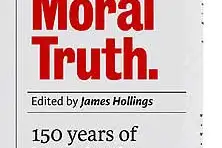
In a world of fake news and social media noise, investigative journalism is surely more vital than ever.
In an exciting new book published this month, journalism academic James Hollings writes, “The great Australian journalist John Pilger suggests that good investigative journalism holds power to account, and acts as a check on power. For him, it is not just about ‘detective work’, but must also be journalism that ‘bears witness and investigates ideas.’”
So how does New Zealand’s investigative journalism track record stack up? Surprisingly well. As Hollings says in his introduction: “Many times when I told people I was gathering material for this book I had a response along the lines of ‘That will be short book’ . . . Weigh this book in your hand and judge for yourself how true that statement is. There is in fact a long and rich tradition here of journalism that holds power to account that goes beyond allegation and denial to reveal hidden truths.”
In fact, that tradition goes right back to 1863 and the independent Maori newspaper Te Hokioi. In A Moral Truth, Hollings gathers together 33 outstanding exemplars of the investigative journalist’s craft. He introduces each one, giving the historical background against which it was written, and often including an interview with its author, and then the piece is either reproduced in full or in extract form. It’s a window into some of the darkest moments in New Zealand’s past — a marvellous way for the reader to reacquaint themselves with famous early investigations or to discover issues from an earlier era. There are some famous names here: Hilda Rollett, Robyn Hyde, Pat Booth, Sandra Coney, Philip Kitchin, Mike White, Nicky Hager and Bruce Ansley amongst them, and others less well-known that will surprise you.
Common to all 33 stories, Hollings notes, is the determination and tenacity of journalists and the courage of their editors. Hollings observes how the ebb and flow of investigative energies has tended, over time, to depend on the tenure of particularly brave editors at certain publications. Here he cites luminaries such as Pat Booth, Warwick Roger, Tim Pankhurst and Robbie Burton. His instructive and thoughtful introduction also canvases the chilling effect of New Zealand’s culture of censorship on the ability to pursue investigations.
The 448-page book contains surprises, among them the powerful and affecting pieces from Truth, and Robyn Hyde on Bastion Point. Old heartaches are revisited: Lesley Max’s pioneering expose of child abuse, the death of toddler Delcelia Witika, is reproduced in full, as is the story of the ‘unfortunate experiment’ at National Women’s Hospital.
Hollings’ introductory essay also includes interviews with the journalists, where that has been possible. Reading Pat Booth, Sandra Coney and Lesley Max, for example, reflecting on their stories many years afterwards is fascinating.
“These stories reveal the resilience and enduring power of New Zealand journalism,” James Hollings says. “Many had a real and measurable impact at the time of publication or shortly afterwards . . . They show us, above all, that on the right story, with the right effort, journalism can convey a moral truth.”
About the editor
Dr James Hollings is the head of Journalism at Massey University in Wellington; the home of New Zealand’s oldest continuously operating journalist training school. Before joining Massey he was a journalist for 18 years and worked in senior roles in newspapers and radio. Much of this was at The Evening Post, in Wellington, where he won the Jubilee Prize for Investigative Journalism and a Qantas Award. His doctoral dissertation was on whistle-blowers, and he has published on the characteristics and attitudes of New Zealand journalists, media reporting of suicide, disaster reporting, and the practice of investigative journalism. He is co-founder of the New Zealand Centre for Investigative Journalism. He lives in Wellington with his partner and three children.